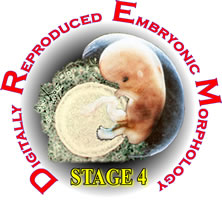

| Opening Screen | Help / Instructions |
| In Vitro Micrographs | Credits |
Stage 4 is reserved for the attaching blastocyst that is adhering to the endometrial lining of the uterus. The attaching process is called adplantation and heralds the onset of implantation. Stage 4 embryos have an estimated postfertilization age of approximately 6 days.There are no known in vivo human specimens at stage 4.
IN VITRO HUMAN EMBRYOS
Several researchers have published scanning (SEM) and transmission (TEM) electron micrographs of stage 4 human embryos in vitro which are included on the disk (Figs. 1-15). Credit for each of these images is given in the figure legends. These investigators provided insights into the adplantation process by placing cultured blastocysts on monolayers of cultured endometrial epithelial cells. In vitro development of stage 4 embryos does not exactly reflect the in vivo situation since the endometrial stroma and maternal hormone influences are not present, no decidua forms, and growth is limited.
![]()
Bentin-Ley, U., Sjögren, A., Nilsson, L., Hamberger, L., Larsen, J. F., and Horn, T., (1999) Presence of uterine pinopodes at the embryo-endometrial interface during human implantation in vitro. Human Reprod. 14:515-520.
Bentin-Ley U., Horn T., Sjögren A., Sorensen S., Larsen J. F., and Hamberger, L. (2000) Ultrastructure of human blastocyst-endometrial interactions in vitro. J. Reprod. Fertil. 120:337-350.
Lindenberg, S., Hyttel, P., Lenz, S., and Holmes, P.V. (1986) Ultrastructure of the early human implantation in vitro. Human Reprod. 1:533-538.
Lindenberg, S. (1991) Ultrastructure in human implantation: Transmission and scanning electron microscopy. Baillieres Clin. Obstet. Gynaecol. 5:1-14.